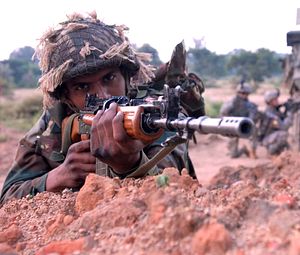Is India’s defense budget adequate? My colleague Franz has a useful breakdown of India’s defense spending, as per its recently announced budget (which I look at more generally here). Indeed, India’s defense budget does look rather limited given where most of the spending is going. A large portion of scheduled spending will go into the maintenance of India’s large standing military, the world’s third largest, and a similarly large sum will go to paying military pensions — a sum greater than the budget’s allocation for the Indian Air Force and Navy. At $40 billion, India’s budget will likely additionally fail to realize a major goal of the Narendra Modi government in the immediate term, which is to indigenize the production of advanced weaponry. Still, India’s military budget might be entirely adequate for its expected threat environment.
First, the defense budget should be considered in terms of India’s most important strategic objectives. What is the top external threat for India? If the Indian military were to engage in combat with any other conventional army, the expected enemy would first and foremost be Pakistan. War between India and Pakistan is not a topic of distant possibility; the two neighbors have fought three conventional wars since their creation in 1947. Indian and Pakistani troops continue to constantly engage in skirmishes across the Line of Control in Kashmir. Given this backdrop, the Indian armed forces need to prioritize their readiness over investment in newer technologies, despite the potential benefits of those investments. India has never quite been able to do both. As the 1999 Kargil War — the most recent war between India and Pakistan –demonstrated, the lead up to a full-on conventional conflict may be sudden, demanding an immediate effective response. Thus, any Indian military budget will have to invest in maintaining existing assets and ensuring readiness.
Second, recent trends in high-level India-China diplomacy, including last fall’s summit between Modi and Chinese President Xi Jinping, suggest that India and China are looking to seriously address their border dispute and are looking to reduce tensions along their border. Insofar as India-China relations are concerned right now, a security “dilemma” does not quite exist — New Delhi may make military spending decisions based on perceived fears of a Chinese “string of pearls” in the Indian Ocean or a potential repeat of a 1962-style defeat at Chinese hands, but Beijing does not reciprocate by militarizing its border with India. As the term implies, a security dilemma needs two parties to encourage spiraling increases in defense spending. Beijing is increasing its military spending, but its attentions is mostly directed outward from the Asian rimland, toward the East and South China Seas and the first island chain. True, the Sino-Indian borderlands are nowhere near what can be considered demilitarized, but New Delhi has been able to build up its capabilities over the years without causing outright panic in the PLA. This is a good thing as far as India is concerned.
Still, while a case can be made for the adequacy of the Indian budget allocation for defense, mere adequacy will not satisfy India’s long-term security needs. Investments in foreign advanced weaponry, an indigenous defense industrial capacity, and research and development are necessary if the Indian military is to keep up with regional military modernization trends.

































